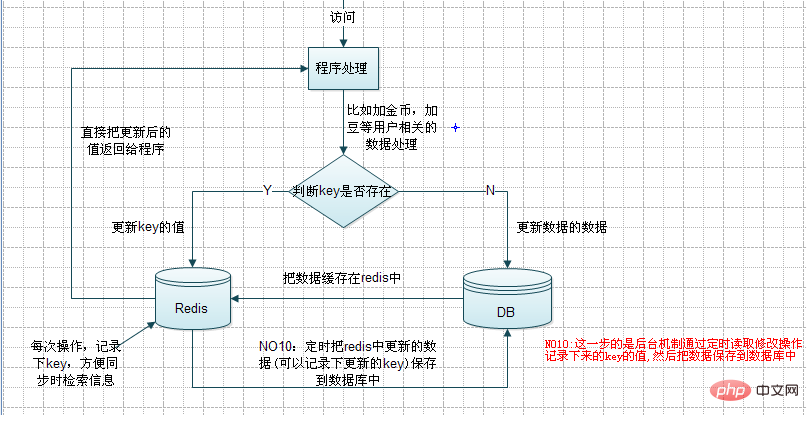How to synchronize redis cache with database
Consistency between cached data and persistent data, this problem is summarized (I saw a good blog post), it is actually reading and writing, and there is also the issue of who comes first and who comes last. .

Theoretically, setting an expiration time for the cache is a solution to ensure eventual consistency. Under this solution, we can set the expiration time for the data stored in the cache. All write operations are subject to the database, and we only need to do our best for cache operations. (Recommended learning: Redis video tutorial)
That is to say, if the database write is successful and the cache update fails, then as long as the expiration time is reached, subsequent read requests will naturally read new values from the database and backfill the cache.
Redis is a high-performance key-value database. The emergence of redis has largely compensated for the shortcomings of key-value storage such as memcached, and can play a very good supplementary role to relational databases in some situations. It provides python, Ruby, Erlang, and PHP clients, which are very convenient to use.
According to our general scenario of using Redis, it should be like this:

In other words: we will go to redis first Determine whether the data exists. If it exists, return the cached data directly. If it does not exist, it will go to the database, read the data, and cache the data into Redis.
Applicable occasions: If the amount of data is relatively large, but it is not updated frequently (such as user rankings)
The use of the second type of Redis is completed with the first situation Different, please see the specific situation:

Here we will first go to redis to determine whether the data exists. If it exists, then directly update the corresponding data (this step The corresponding updated key will be recorded, for example, it will also be saved in redis. For example: the key is: save_update_keys [recorded with lpush list]), and the updated data will be returned to the page. If it does not exist, the content in the database will be updated first, and then a copy of the data will be saved in Redis.
NO10 Step: Later work: There will be relevant mechanisms in the background to read the keys stored in save_update_keys in Redis respectively, find the corresponding data, and update it to the DB.
Advantages: The main purpose of this process is to use Redis as a database, and updating and obtaining data is faster than DB. It is very suitable for frequent changes in large amounts of data (such as Weibo).
Disadvantages: It relies heavily on Redis, so it is necessary to save data during downtime. (However, you can use the snapshot AOF of redis. If you recover quickly, it should not have much impact, because even if Redis stops working, it will not affect subsequent data processing.)
Difficulty: planning the key in the early stage Format and storage type are important because they will affect whether the data can be synchronized to the DB.
The above is the detailed content of How to synchronize redis cache with database. For more information, please follow other related articles on the PHP Chinese website!

Hot AI Tools

Undresser.AI Undress
AI-powered app for creating realistic nude photos

AI Clothes Remover
Online AI tool for removing clothes from photos.

Undress AI Tool
Undress images for free

Clothoff.io
AI clothes remover

Video Face Swap
Swap faces in any video effortlessly with our completely free AI face swap tool!

Hot Article

Hot Tools

Notepad++7.3.1
Easy-to-use and free code editor

SublimeText3 Chinese version
Chinese version, very easy to use

Zend Studio 13.0.1
Powerful PHP integrated development environment

Dreamweaver CS6
Visual web development tools

SublimeText3 Mac version
God-level code editing software (SublimeText3)

Hot Topics
 1386
1386
 52
52
 How to build the redis cluster mode
Apr 10, 2025 pm 10:15 PM
How to build the redis cluster mode
Apr 10, 2025 pm 10:15 PM
Redis cluster mode deploys Redis instances to multiple servers through sharding, improving scalability and availability. The construction steps are as follows: Create odd Redis instances with different ports; Create 3 sentinel instances, monitor Redis instances and failover; configure sentinel configuration files, add monitoring Redis instance information and failover settings; configure Redis instance configuration files, enable cluster mode and specify the cluster information file path; create nodes.conf file, containing information of each Redis instance; start the cluster, execute the create command to create a cluster and specify the number of replicas; log in to the cluster to execute the CLUSTER INFO command to verify the cluster status; make
 How to clear redis data
Apr 10, 2025 pm 10:06 PM
How to clear redis data
Apr 10, 2025 pm 10:06 PM
How to clear Redis data: Use the FLUSHALL command to clear all key values. Use the FLUSHDB command to clear the key value of the currently selected database. Use SELECT to switch databases, and then use FLUSHDB to clear multiple databases. Use the DEL command to delete a specific key. Use the redis-cli tool to clear the data.
 How to read redis queue
Apr 10, 2025 pm 10:12 PM
How to read redis queue
Apr 10, 2025 pm 10:12 PM
To read a queue from Redis, you need to get the queue name, read the elements using the LPOP command, and process the empty queue. The specific steps are as follows: Get the queue name: name it with the prefix of "queue:" such as "queue:my-queue". Use the LPOP command: Eject the element from the head of the queue and return its value, such as LPOP queue:my-queue. Processing empty queues: If the queue is empty, LPOP returns nil, and you can check whether the queue exists before reading the element.
 How to use the redis command
Apr 10, 2025 pm 08:45 PM
How to use the redis command
Apr 10, 2025 pm 08:45 PM
Using the Redis directive requires the following steps: Open the Redis client. Enter the command (verb key value). Provides the required parameters (varies from instruction to instruction). Press Enter to execute the command. Redis returns a response indicating the result of the operation (usually OK or -ERR).
 How to use redis lock
Apr 10, 2025 pm 08:39 PM
How to use redis lock
Apr 10, 2025 pm 08:39 PM
Using Redis to lock operations requires obtaining the lock through the SETNX command, and then using the EXPIRE command to set the expiration time. The specific steps are: (1) Use the SETNX command to try to set a key-value pair; (2) Use the EXPIRE command to set the expiration time for the lock; (3) Use the DEL command to delete the lock when the lock is no longer needed.
 How to read the source code of redis
Apr 10, 2025 pm 08:27 PM
How to read the source code of redis
Apr 10, 2025 pm 08:27 PM
The best way to understand Redis source code is to go step by step: get familiar with the basics of Redis. Select a specific module or function as the starting point. Start with the entry point of the module or function and view the code line by line. View the code through the function call chain. Be familiar with the underlying data structures used by Redis. Identify the algorithm used by Redis.
 How to solve data loss with redis
Apr 10, 2025 pm 08:24 PM
How to solve data loss with redis
Apr 10, 2025 pm 08:24 PM
Redis data loss causes include memory failures, power outages, human errors, and hardware failures. The solutions are: 1. Store data to disk with RDB or AOF persistence; 2. Copy to multiple servers for high availability; 3. HA with Redis Sentinel or Redis Cluster; 4. Create snapshots to back up data; 5. Implement best practices such as persistence, replication, snapshots, monitoring, and security measures.
 How to use the redis command line
Apr 10, 2025 pm 10:18 PM
How to use the redis command line
Apr 10, 2025 pm 10:18 PM
Use the Redis command line tool (redis-cli) to manage and operate Redis through the following steps: Connect to the server, specify the address and port. Send commands to the server using the command name and parameters. Use the HELP command to view help information for a specific command. Use the QUIT command to exit the command line tool.




